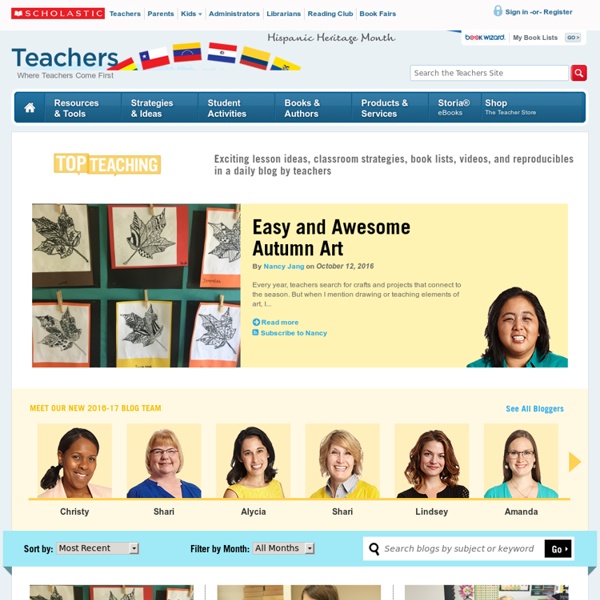



http://www.scholastic.com/teachers/teaching-ideas
Jeff's Edublog Naked Eye Observation Telescopic Observation Spacecraft flyby mission Orbiter observations Planetary Lander Detailed view of landscape Finding Life continue reading This post contains information and resources presented by Jeff Stanger at the 15th Biennial Science Teachers Workshop, The University of Sydney, November 5th, 2012. Wikis, Google or Office Docs as collaborative workspaces A summary of my use of wikis or shared documents as collaborative workspaces is contained within this article A video illustrating the use [...] continue reading
Learners NOT Students! All of us are learners. Think about it. We were born curious and open to learning or we wouldn't walk or talk. It's just how each of us were made. Learning is part of us. We were not born students -- we were born learners. Book Wizard Mobile: Level books and create book lists on your iPhone, iPad and Android devices. Read our Frequently Asked Questions about Book Wizard Mobile – now available FREE for iPhones and iPads with retina display and Android devices! Scan Tap Scan to find books by scanning the bar code. Tap Search, then type or say a book’s title, author or keyword.
Think Inclusive By John Spencer When I first volunteered to teach a self-contained classroom of English Language Learners (ELL), I assumed the issue would be a language barrier. After spending a few years learning about the best practices for language acquisition, I developed lesson plans that would provide the right accommodations. :Roll up your sleeves and get messy “Reading” Sebastien Wiertz Close reading is one of the “strategies du jour”. From the Common Core State Standards in ELA: 1. Read closely to determine what the text says explicitly and to make logical inferences from it; cite specific textual evidence when writing or speaking to support conclusions drawn from the text. In addition from the Harvard Writing Center:
ict4meandyou.wikispaces You are not a member of this wiki. Join now Dismiss guest | Join | Help | Sign In HOME Photos & Videos Sessions PhotoShop iPod & iPads Webtools Captivate SRN Adobe Presenter Photos & Videos Better Group Work Experiences Begin with How the Groups Are Formed July 31, 2013 By: Maryellen Weimer, PhD in Teaching Professor Blog Like many matters regarding teaching and learning, there isn’t one best way to put students into groups. The best way is related to what you want students to learn from their group experience. Here’s a brief discussion of how that works for three common ways of forming groups.
Top Teaching Forty-one tabs. Seriously, I had 41 tabs open on my laptop at once. Forty-one glorious gems that I just could not close, many of them printable resources ready to be utilized immediately. Time spent finding these resources? Education Week By Catherine Gewertz April 7, 2015 at 11:20 AM Ohio joins a small but growing number of states that are seeking or considering federal permission to excuse some schools or districts from state-mandated tests. By Liana Heitin April 7, 2015 at 9:52 AM Just a heads-up to readers that Ed Week is offering a package of articles about math instruction, several of which focus on the Common Core State Standards for math, for free until April 15.
OneNote – A Practical Tip « First Steps We started using OneNote with our Year 9 English classes in 2009 and continued with the process as they moved into Year 10 in 2010. Our Year 9 students that have just received their laptops have now also begun the process of using OneNote as their English book. (Please see my previous post for how we set up the OneNote notebooks as templates for the entire cohorts.) This has been going swimmingly, and apart from spelling tests and in-class writing tasks, we have rarely used their exercise book since. This led us to a unique challenge though. We collect student books once per term to check on their work, mark work and give feedback as to progress, etc.
Lessons Learned from My Students June 13, 2013 By: Candice Dowd Barnes, EdD in Teaching and Learning My students have taught me some invaluable lessons during my first two years as a college professor. I’d like to share three of the most important ones here. They aren’t new lessons and I didn’t use any unique methods to learn them. I collected data midsemester from students, I talked with them, and I looked closely at what was happening in my classroom.
Immigration: Stories of Yesterday and Today and Ellis Island World War II and the Postwar Period The United States entered World War II in 1942. During the war, immigration decreased. There was fighting in Europe, transportation was interrupted, and the American consulates weren't open. Fewer than 10 percent of the immigration quotas from Europe were used from 1942 to 1945.In many ways, the country was still fearful of the influence of foreign-born people. The United States was fighting Germany, Italy, and Japan (also known as the Axis Powers), and the U.S. government decided it would detain certain resident aliens of those countries. Education Week By Jennie Magiera May 21, 2015 at 8:19 AM On April 12th, my students threw down a challenge to the world: Create a video about coding and/or creativity and send it to us. They would then pick the top video and the winner would receive two new robotic friends that inspire us to code: Dash and Dot, courtesy of Wonder Workshop. The loved all the submissions so much and had a hard time narrowing it down... but ultimately they made a decision.